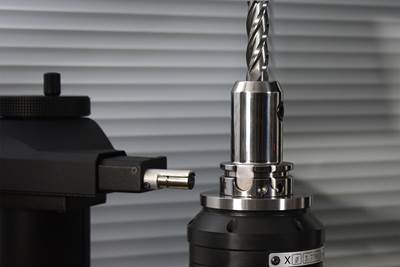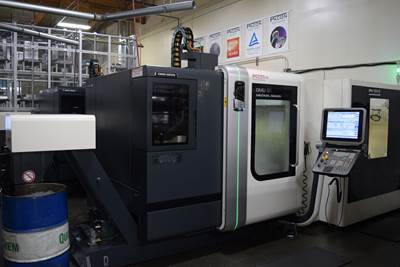Refining Shopfloor Processes for Mission-Critical Parts
Pacon Mfg, Inc. has not rested on its laurels as the 2020 Top Shop Honoree for Shopfloor Practices and Performance. In the years since, it has refined its processes to continue excelling in a volatile market.
Share





PACON’s strenuous adherence to quality standards enables it to manufacture mission-critical parts, such as the housing for the MOXIE experiment box on NASA’s Mars 2020 Perseverance Rover.
Even a Top Shop can benefit from process refinement, and in the four years since Pacon Mfg, Inc. (also called PACON after founders Paul and Connie) qualified as the 2020 Top Shops Honoree in Shopfloor Practices and Performance, the shop has continued thriving due to its enduring focus on the same ideas that led to it becoming a Top Shop. In addition to its automated five-axis workflow, this has involved the acquisition of a second location to offload operations better suited to other types of machining processes, as well as an increasing investment in software to meet the ever-evolving needs of its customers.
Mission-Critical Machining
Most of PACON’s parts are mission critical in one way or another. The company works with clients in the space, defense, life science, semiconductor and automation industries, all of whom require tight tolerances for their expensive parts. Many of these customers have also introduced stricter traceability requirements over the last few years, necessitating paperwork and traceability all the way from final checks to the initial production of parts’ raw materials. Many parts include features that have tolerances of 0.0002 inch — not just for location repeatability, but for perpendicularity and flatness.
Steve McClure, CEO of PACON, says that while meeting location repeatability is relatively simple, reaching the perpendicularity and flatness tolerances are more difficult. He says that the quality of the machine and workholding have a lot to do with ultimately reaching these tolerances, and that five-axis machining is well suited for machining parts where surfaces must be related to one another. As such, the shop has standardized on five-axis machines and common workholding — as was covered in the 2020 Top Shops article.
At that time, the shop was well-equipped to handle its workflow, which was about evenly distributed between its work segments. In the years since, the instability inflicted by COVID has stress-tested the shop’s systems, showing the strength in many of them while also presenting challenges that required further process refinement.
Cell Service
Walking onto the shop floor of PACON’s original location in Livermore, California, the 60-pallet Makino MMC2 flexible machining system (FMS) commands a lot of attention. The system is connected to two Makino a500Z horizontal five-axis machines, each with a 313-tool magazine and tool breakage detection systems. The different pallet slots have different vise configurations for different types of part configurations, with the FMS running “air traffic control for the machine,” as McClure puts it, by keeping track of which program goes to which pallet.

PACON standardized on horizontal five-axis machines to cut the number of setups on its parts and increase process predictability. This, when paired with the shop’s simulation software, has enabled the shop to send completed programs directly to the cell, eliminating the divide between production and prototyping.
During the initial setup of the cell, PACON’s team looked at about three years’ worth of repeat parts, grouped them, and developed hypothetical pallets to machine these parts in batches. Ultimately, they found that so long as work on a pallet is running for an hour — no matter whether the pallet is dedicated to one part or multiple — it becomes profitable. The Makino a500Z machines also share about two-thirds of their tooling, so either one can tackle most of the pallets for lights-out automation.
This was especially important at the outbreak of the COVID-19 pandemic, when PACON’s life sciences customers urgently needed components to produce PCR tests. Producing these components in sufficient quantities required a massive increase in productivity, even as many of the shop’s other customers continued ordering. McClure says the cell was the key to meeting this surge. With standard pallets and tooling, the cell was able to perform work lights-out and perform a year’s worth of production in two months — without sacrificing the shop’s other customers.
Dynamic(s) Automation
PACON’s other big automation push centers on its quality department and its software. With 75% of parts requiring evidence of quality beyond a certificate of conformance and defense customers wanting full inspection reports on every unit of every part number, the shop has needed to juggle a large paper trail for every one of these parts. Accomplishing this efficiently has required the automation of front office tasks and the digitization of the material chain of custody. To do so, the shop has sought after an ERP to match the lean philosophy of its shop floor.
In 2023, this led PACON to adopt Microsoft Dynamics Business Central as its ERP system. This system has the power to capture part documentation and quality records from their point of origin, connect these documents to the correct shipments and lots, automate basic communications such as advance shipping notices and carry forward the barcode-driven production monitoring the shop began under its previous ERP. McClure also says that Windows 11 and the Microsoft 365 environment are useful for meeting CMMC requirements, with features like built-in support for document encryption and Multi-Factor Authentication access control on user devices.
Beyond ERP, PACON manages its part quality through a Hexagon CMM programmed using customer models and a repeatable program to take critical dimension inspection reports. It also relies on a combination of Mastercam for CNC programming and Vericut for NC program simulation.

The parts PACON creates can have tolerances down to 0.0002 inch, and require closely related work on multiple surfaces. Steve McClure, CEO of PACON, credits the shop’s success at reaching these tolerances to the quality of its machines and workholding.
With Mastercam, McClure says the shop leverages tool path generation algorithms wherever possible, with special emphasis on OptiRough. He says these algorithms cut a lot of time not just from programming, but from machining cycle times as well, and that they provide a high-quality finish. The shop then runs the part program, complete with its tooling and fixturing, in Vericut. This simulation software detects potential crashes during the program and can also compare the final simulated part to the blueprint, with highlights showing where the simulated program would cut too much or not enough.
A Tale of Two Shops
Completed programs go onto PACON’s floor day and night, with the shop’s pallet system eliminating the divide between production and prototyping. But even with lights-out pallets, the FMS is not the right machine for every job. Sometimes a feature requires turning, or could be easily completed with three-axis work.
Acquiring a second location in Morgan Hill, California, has given PACON the capacity and capability to handle these jobs. McClure says there is a lot of knowledge sharing at the shops, and the ability to access two labor pools — the eastern San Francisco Bay Area from Livermore, and the southern from Morgan Hill — has been useful for keeping machines staffed. The two facilities are only about an hour to an hour and a half drive apart, depending on traffic, so parts can be transferred between them depending on which facility’s machines and expertise better suit the part. PACON can also optimize its work mix at each facility, ensuring more consistent utilization for its FMS and five-axis mills in Livermore and its lathes and three-axis mills in Morgan Hill.
For the future, PACON is looking to further automate its inspection capabilities and potentially expand its capabilities with multi-axis moving-head mill-turns. The shop also plans to continue maturing its automation implementation with ERP so that it can dynamically respond to front office work as it now can with work for its FMS. With its core markets on an upswing, the shop only plans to get busier — but its workflow is poised to handle these upswings without trouble.
Related Content
Orthopedic Event Discusses Manufacturing Strategies
At the seminar, representatives from multiple companies discussed strategies for making orthopedic devices accurately and efficiently.
Read MoreHow to Successfully Adopt Five-Axis Machining
While there are many changes to adopt when moving to five-axis, they all compliment the overall goal of better parts through less operations.
Read More4 Commonly Misapplied CNC Features
Misapplication of these important CNC features will result in wasted time, wasted or duplicated effort and/or wasted material.
Read MoreHigh RPM Spindles: 5 Advantages for 5-axis CNC Machines
Explore five crucial ways equipping 5-axis CNC machines with Air Turbine Spindles® can achieve the speeds necessary to overcome manufacturing challenges.
Read MoreRead Next
How a Custom ERP System Drives Automation in Large-Format Machining
Part of Major Tool’s 52,000 square-foot building expansion includes the installation of this new Waldrich Coburg Taurus 30 vertical machining center.
Read More4 Ways “Tag and Track” Technology Keeps Data Chains Intact
Scannable images and tags inextricably link relevant information with workpieces, cutting tools and other physical assets.
Read MoreStandardization Leans the Way to High-Mix Automation
An increasingly digitalized, lean manufacturing process begins with a common selection of cutting tools and five-axis machining fixtures.
Read More































.jpg;maxWidth=970;quality=90)